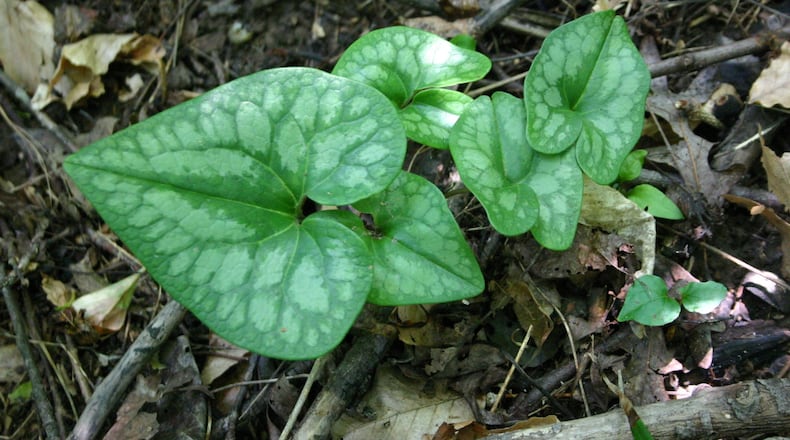Q: As a kid, we would hunt what we called “piggies” in the woods. As I remember, the leaves were sort of heart shaped and when we found them we would bend away the leaves so the little piggies could be seen. Sonja Hayes, Douglasville
A: What a delightful memory! The plant you were looking for is commonly called little brown jug or heartleaf ginger, Hexastylis arifolia. The flowers hidden under the leaves resemble small, open-mouthed pigs or perhaps amphorae that the Romans used to carry wine. The heart-shaped leaves have dark green veins and leaf edges. Its close cousin, largeflower heartleaf, Hexastylis shuttleworthii, has whitish veins and leaf edges. The flowers are pollinated by ground-dwelling insects. Their color ranges from light green in the spring to maroon or brown in fall.
Q: Does crabgrass pre-emergent have a shelf life while stored in a bag?Steve Middendorf , email
A: As long as the product is kept dry and away from temperature extremes, pre-emergents will be effective for at least three years.
Q: I have a white, sticky substance on my hemlock trees up at Lake Burton. Any advice would be appreciated.Glory Sanders, email
A: It's very likely you are seeing hemlock adelgid insects. These sap sucking creatures have killed thousands of hemlocks in north Georgia. They can be controlled on individual trees with a systemic insecticide drench.
Q: What is the difference between Azalea, Camellia, Rhododendron fertilizer (34-10-10) and Azalea, Camellia, Rhododendron fertilizer (3-4-3)?Lauren Spahn, Inman
A: As you know, fertilizer products are made by mixing different chemicals together. These chemicals supply the nitrogen, phosphorus, and potassium that plants need. Some chemicals dissolve in water quickly, so they are immediately available for roots to suck up and feed the plant. Others dissolve slowly and last longer in the soil. Generally speaking, any fertilizer product with numbers above 6 is a fast-dissolving fertilizer, although some fast-dissolving fertilizers are coated to slow down the process. A product with numbers of 6 and below is typically made from organic materials that dissolve slowly. Many gardeners note that the slow-release products contain lots of micronutrients (calcium, iron, magnesium,etc) that fast-release products do not have.
Q: Is the Golden Jackpot barberry invasive here?Kathryn Wood, Cumming
A: It is hard to know. Japanese barberry is very invasive in some parts of the country, like New England, but does not seem to be as vigorous in the Southeast. Yellow-leafed forms of barberry are reputed to have fewer flowers and fruit. If you plant it, let me know! For more than you ever wanted to know about barberry invasiveness, see bit.ly/GAbarberry.
About the Author
The Latest
Featured

